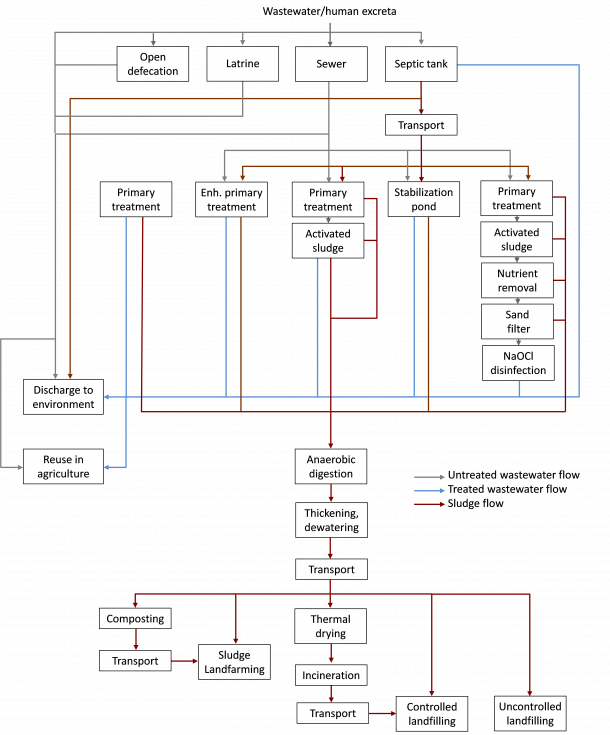Wastewater LCI Initiative
Do you need to model in your LCA studies the environmental impact of wastewater, or of specific chemicals present in wastewater? The Wastewater LCI Initiative by 2.-0 LCA consultants has led to the development of WW LCI, an Excel-based model that calculates life cycle inventories for urban wastewater discharges in more than 100 countries.
The client
Crowdfunded project
Our role
2.-0 LCA consultants started in 2015 an initiative to develop a model to address the substance-specific fate and effect of chemicals in wastewater.
Background
Very often the fate of chemicals after use is to be sent to municipal wastewater treatment plants (WWTP). Current LCI models typically reflect the average conditions in WWTPs, rather than the specific fate of particular chemicals. However, different chemicals behave differently in WWTPs, depending on their physical-chemical properties and biodegradability. An accurate modelling of the life cycle impacts of chemicals requires taking into account this specific behaviour in a WWTP, namely whether a chemical will be either degraded, volatilized, partitioned to sludge, discharged unchanged, or a combination of these. There were no available LCI models to solve this particular problem.
Besides the issue of specific chemicals in wastewater, LCA practitioners often only have access to a limited set of pollution descriptors to describe a wastewater, such as chemical oxygen demand (COD), suspended solids (SS) or total nitrogen. Even in this case, the available LCI tools/models to address the impact of this pollution are far from complete.
Last but not least, available models often reflect wastewater disposal practices in developed countries, where connection to WWTPs is widespread. There are no available LCI models tackling the reality of wastewater management diversity around the world, especially in developing countries.
The development of WW LCI provided a solution to all these shortcomings.
WW LCI
2.-0 LCA consultants started in 2015 an initiative to develop a model and tool to address the impact of chemicals in wastewater. The result of this effort is WW LCI, an Excel-based model that calculates life cycle inventories of wastewater discharges, including the following aspects (see also figures 1 and 2):
- The fate of substances in WWTPs and downstream in the environment (air, water, soil).
- Direct and indirect emissions from wastewater collection and treatment at different WWTP levels (primary, activated sludge, lagooning, tertiary treatment), taking into account local climatic conditions.
- Domestic sanitation through septic tanks, latrines and open defecation.
- Wastewater reuse in agriculture.
- Sludge disposal through composting, landfarming, incineration, controlled landfilling and uncontrolled landfilling.
- Greenhouse-gas and other indirect emissions from degradation of substances in the environment, in the case they are not degraded in a WWTP or subject to treatment at all.
- A database with country-specific data on wastewater management for more than for 100 countries and two regions (see figure 2): connection to sewer, WWTP treatment levels, sludge disposal practices, discharges to freshwater/seawater, capacity of operating WWTPs, availability of anaerobic digestion and cogeneration, etc.
- Inventories linked to ecoinvent as background system, in an easy format for export to LCA software (SimaPro, GaBi).

Figure 1. An overview of the foreground processes included in WW LCI.

Figure 2. Geographical coverage of the country database in WW LCI.
WW LCI has been the subject of two peer-reviewed publications (ref 1, ref 2) and six presentations at international conferences (ref 3, ref 4, ref 5, ref 6, ref 7, ref 8). Below you can access the latest documentation for WW LCI:
WW LCI v.5_Model documentation_20250107
WW LCI v5_user manual_20250107
Some examples of what you can do with WW LCI
WW LCI is an extremely versatile tool, which can be used to obtain inventories for LCA studies addressing either wastewater systems as such, or the end-of-life stage of products involving the production of wastewater, e.g. cleaning products, personal-care products, industrial chemicals, food production and even human excretion. To give you an idea of what can be done, below we provide some random examples of applications where WW LCI is fully capable of providing life cycle inventories (once the user defines the wastewater composition) for more than 100 countries:
- LCI for discharging a detergent formulation in wastewater.
- LCI for a direct discharge of a shampoo formulation.
- LCIs for discharging Ibuprofen, Atrazine, Nickel and Lead in wastewater
- LCI for discharging an industrial wastewater with 2000 mg/L COD to urban wastewater collection systems.
- LCI for domestic wastewater treatment in septic tanks vs. tertiary treatment with nutrient removal in a WWTP treating 10,000 m3/day.
- LCI for domestic wastewater treatment in a WWTP with and without anaerobic digestion of sludge and cogeneration of heat and power.
- LCI for direct discharge of domestic wastewater in open, stagnant sewers.
- LCI for disposing of wastewater sludge through incineration with energy recovery vs. uncontrolled landfilling.
- LCI for discharging urine to WWTPs vs. open defecation or latrines.
- LCI for treated vs. untreated wastewater reuse in agriculture.
See a webinar (1.5 hour) on the model from our YouTube channel:
And a presentation about the new features in the latest model version WW LCI v5 also on YouTube.
Subscription
The Wastewater LCI initiative is open to everyone. Subscription grants access to the excel-based tool WW LCI and a helpdesk to solve your problems when you start using it.
Some of our current members
- Henkel
- L’Oréal
- Procter and Gamble
- Umeå University, Green Technology and Environmental Economics Research Initiative
- Unilever
- University of Bordeaux
- Fraunhofer-Institute for Environmental, Safety, and Energy Technology UMSICHT
- PRé Sustainability
- Brunel University London
- Kocaeli University
- Xi’an Jiaotong University
- UNSW Sydney
- LUT University
- Eurecat, Centre Tecnològic de Catalunya
- FIT Instituto de Tecnologia da Amazonia
- Sayari
- University of Stuttgart, Institute for Sanitary Engineering, Water Quality and Solid Waste Management
- Georgia Institute of Technology
- Svendborg Vand og Affald
- Nanyang Technological University, Nanyang Environment and Water Research Institute (NEWRI)